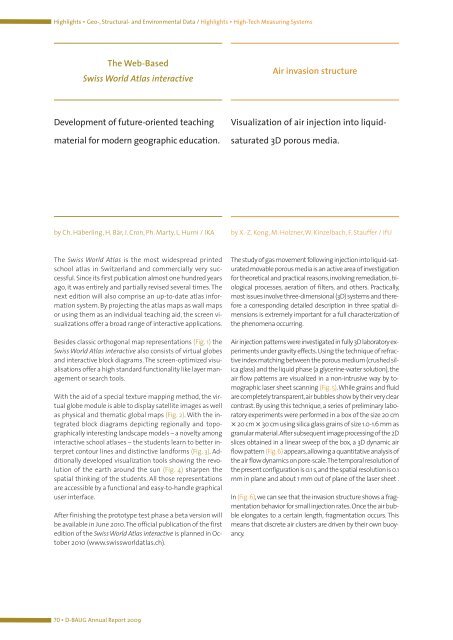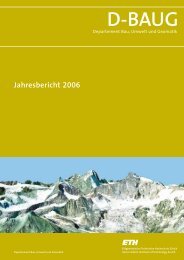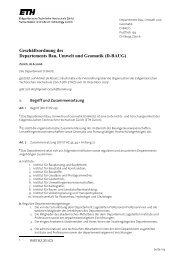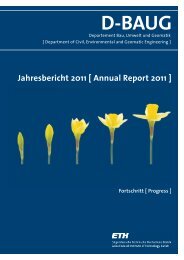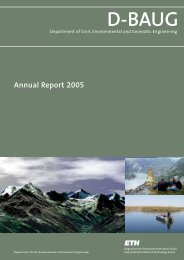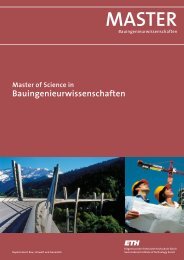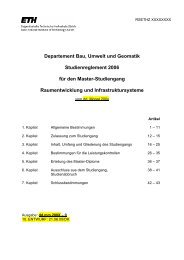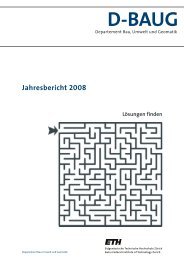D-BAUG - Departement Bau, Umwelt und Geomatik - ETH Zürich
D-BAUG - Departement Bau, Umwelt und Geomatik - ETH Zürich
D-BAUG - Departement Bau, Umwelt und Geomatik - ETH Zürich
Create successful ePaper yourself
Turn your PDF publications into a flip-book with our unique Google optimized e-Paper software.
Highlights ▪ Geo-, Structural- and Environmental Data / Highlights ▪ High-Tech Measuring Systems<br />
The Web-Based<br />
Swiss World Atlas interactive<br />
Development of future-oriented teaching<br />
material for modern geographic education.<br />
by Ch. Häberling, H. Bär, J. Cron, Ph. Marty, L. Hurni / IKA<br />
The Swiss World Atlas is the most widespread printed<br />
school atlas in Switzerland and commercially very successful.<br />
Since its first publication almost one h<strong>und</strong>red years<br />
ago, it was entirely and partially revised several times. The<br />
next edition will also comprise an up-to-date atlas information<br />
system. By projecting the atlas maps as wall maps<br />
or using them as an individual teaching aid, the screen visualizations<br />
offer a broad range of interactive applications.<br />
Besides classic orthogonal map representations (Fig. 1) the<br />
Swiss World Atlas interactive also consists of virtual globes<br />
and interactive block diagrams. The screen-optimized visualisations<br />
offer a high standard functionality like layer management<br />
or search tools.<br />
With the aid of a special texture mapping method, the virtual<br />
globe module is able to display satellite images as well<br />
as physical and thematic global maps (Fig. 2). With the integrated<br />
block diagrams depicting regionally and topographically<br />
interesting landscape models – a novelty among<br />
interactive school atlases – the students learn to better interpret<br />
contour lines and distinctive landforms (Fig. 3). Additionally<br />
developed visualization tools showing the revolution<br />
of the earth aro<strong>und</strong> the sun (Fig. 4) sharpen the<br />
spatial thinking of the students. All those representations<br />
are accessible by a functional and easy-to-handle graphical<br />
user interface.<br />
After finishing the prototype test phase a beta version will<br />
be available in June 2010.The official publication of the first<br />
edition of the SwissWorld Atlas interactive is planned in October<br />
2010 (www.swissworldatlas.ch).<br />
70 ▪ D-<strong>BAUG</strong> Annual Report 2009<br />
Air invasion structure<br />
Visualization of air injection into liquid-<br />
saturated 3D porous media.<br />
by X.-Z. Kong, M. Holzner, W. Kinzelbach, F. Stauffer / IfU<br />
The study of gas movement following injection into liquid-saturated<br />
movable porous media is an active area of investigation<br />
for theoretical and practical reasons,involving remediation,biological<br />
processes, aeration of filters, and others. Practically,<br />
most issues involve three-dimensional (3D) systems and therefore<br />
a corresponding detailed description in three spatial dimensions<br />
is extremely important for a full characterization of<br />
the phenomena occurring.<br />
Airinjectionpatternswereinvestigatedinfully3Dlaboratoryexperiments<br />
<strong>und</strong>er gravity effects.Using the technique of refractive<br />
index matching between the porous medium (crushed silica<br />
glass) and the liquid phase (a glycerine-water solution), the<br />
air flow patterns are visualized in a non-intrusive way by tomographic<br />
laser sheet scanning (Fig. 5).While grains and fluid<br />
are completely transparent,air bubbles show by their very clear<br />
contrast. By using this technique, a series of preliminary laboratory<br />
experiments were performed in a box of the size 20 cm<br />
× 20 cm × 30 cm using silica glass grains of size 1.0-1.6 mm as<br />
granularmaterial.Aftersubsequent imageprocessingof the2D<br />
slices obtained in a linear sweep of the box, a 3D dynamic air<br />
flow pattern (Fig.6) appears,allowing a quantitative analysis of<br />
the air flow dynamics on pore-scale.The temporal resolution of<br />
the present configuration is 0.1 s,and the spatial resolution is 0.1<br />
mm in plane and about 1 mm out of plane of the laser sheet .<br />
In (Fig. 6),we can see that the invasion structure shows a fragmentation<br />
behavior for small injection rates.Once the air bubble<br />
elongates to a certain length, fragmentation occurs. This<br />
means that discrete air clusters are driven by their own buoyancy.


